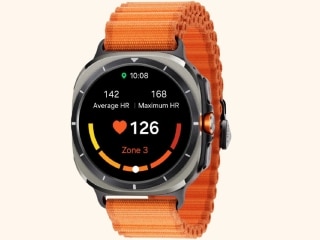- Home
- Mobiles
- Mobiles News
- Google Nexus 6, Nexus 9, Nexus Player With Android 5.0 Lollipop Unveiled
Google Nexus 6, Nexus 9, Nexus Player With Android 5.0 Lollipop Unveiled

The new lineup announced Wednesday is Google's latest volley in its duel with Apple in the increasingly important mobile device market. Google's Android software and Apple's iOS software power most of the world's smartphones and tablets.
The Nexus products, which will hit store shelves in November, also will compete against a variety of other phones and tablets that run on the free Android software, including popular devices made by Samsung Electronics.
Both of the Nexus devices will run on a new version of Google's Android operating system. The latest software is called "Lollipop" in keeping with Google's tradition of naming its Android upgrades after treats.
Google's product unveiling came on the eve of a Thursday event where Apple Inc. is widely expected to update the trend-setting iPad that has defined the tablet market since its 2010 release.
The latest Nexus 9 tablet, made by HTC, features a nearly 9-inch screen - two inches larger than the previous version. The device also will cost considerably more, with prices for the Nexus 9 starting at $399 - 74 percent more than its predecessor. That's still $100 less than the starting price for the current iPad Air, which has a nearly 10-inch screen.
(Also see: Google Nexus 9 With Android 5.0 Lollipop, 64-Bit Tegra K1 Coming This November Starting $399)
The new smartphone, called the Nexus 6, boasts a nearly 6-inch screen, eclipsing the 5.5-inch display on the iPhone 6 Plus that Apple began selling last month.
(Also see: Google Nexus 6 Price and Availability Details Confirmed)
Google is charging a comparable price for the Nexus 6, with prices beginning at $649 for a phone without a wireless contract commitment. That's $300 more than the previous generation, a Nexus 5 with a roughly 5-inch screen.
(Also see: Google Nexus 6 vs. Google Nexus 5 specifications compared)
Consumers can dramatically lower their upfront expense for the Nexus 6 by locking into an Internet data plan with any of the wireless carriers that will begin selling the phone next month. The carriers include A&T, Verizon, Sprint and T-Mobile in the U.S. Google's own Motorola Mobility is making the Nexus 6.
The dramatic price increases on the Nexus devices represents a strategic shift for Google. The Mountain View, California, company traditionally has hailed the Nexus line as state-of-the-art products available at more affordable prices than Apple's devices.
Because Google gives away its Android software, other devices running on the software typically sell for less than the iPhone and iPad. That has enabled more people around the world to buy smartphones and tablets.
But makers of mobile apps have poured more resources into tailoring their products for the iPhone and iPad because the owners of those devices typically have more disposable income to spend.
Google is now aiming for more of Apple's affluent market with the Nexus line while trying to ensure people with lower incomes can still buy smartphones through a recently launched program called Android One. The first Android One phones went on sale in India last month for roughly $100.
Getting more people online benefits Google because the company has built a lucrative digital ad network though its dominant search engine and other services, including email, maps and YouTube video clips.
(Also see: Google Nexus Player Is the First Android TV Device)
Pre-orders for the Nexus 9 and the Android TV player will be accepted beginning Friday. Both devices will reach store shelves on Nov. 3. Advance orders for the Nexus 6 will be accepted toward the end of October and be available in stores at a still-to-be-determined date next month.
Get your daily dose of tech news, reviews, and insights, in under 80 characters on Gadgets 360 Turbo. Connect with fellow tech lovers on our Forum. Follow us on X, Facebook, WhatsApp, Threads and Google News for instant updates. Catch all the action on our YouTube channel.
Related Stories
- Samsung Galaxy Unpacked 2025
- ChatGPT
- Redmi Note 14 Pro+
- iPhone 16
- Apple Vision Pro
- Oneplus 12
- OnePlus Nord CE 3 Lite 5G
- iPhone 13
- Xiaomi 14 Pro
- Oppo Find N3
- Tecno Spark Go (2023)
- Realme V30
- Best Phones Under 25000
- Samsung Galaxy S24 Series
- Cryptocurrency
- iQoo 12
- Samsung Galaxy S24 Ultra
- Giottus
- Samsung Galaxy Z Flip 5
- Apple 'Scary Fast'
- Housefull 5
- GoPro Hero 12 Black Review
- Invincible Season 2
- JioGlass
- HD Ready TV
- Laptop Under 50000
- Smartwatch Under 10000
- Latest Mobile Phones
- Compare Phones
- Realme P4x 5G
- OnePlus Ace 6T
- OPPO A6x 5G
- Samsung Galaxy Z TriFold
- Poco F8 Ultra
- Poco F8 Pro
- Huawei Mate 80 RS Master Edition
- Huawei Mate 80 Pro Max
- Asus ProArt P16
- MacBook Pro 14-inch (M5, 2025)
- Poco Pad M1
- Poco Pad X1
- Just Corseca Skywatch Pro
- Honor Watch X5
- Acerpure Nitro Z Series 100-inch QLED TV
- Samsung 43 Inch LED Ultra HD (4K) Smart TV (UA43UE81AFULXL)
- Asus ROG Ally
- Nintendo Switch Lite
- Haier 1.6 Ton 5 Star Inverter Split AC (HSU19G-MZAID5BN-INV)
- Haier 1.6 Ton 5 Star Inverter Split AC (HSU19G-MZAIM5BN-INV)


















